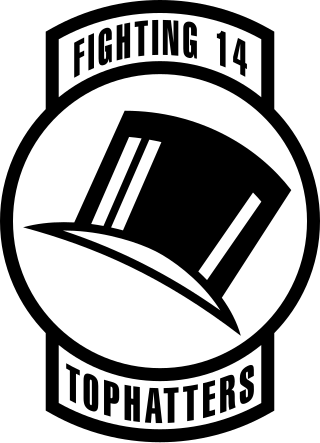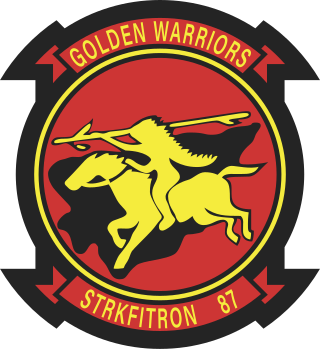
Strike Fighter Squadron 211 (VFA-211), nicknamed the "Fighting Checkmates", is an aviation unit of the United States Navy established in 1945. The squadron is based at Naval Air Station Oceana and is equipped with the Boeing F/A-18E Super Hornet.

The Strike Fighter Squadron 14 (VFA-14) "Tophatters" are a United States Navy fighter attack squadron based at Naval Air Station Lemoore. They fly the F/A-18E Super Hornet, and are the Navy's oldest active squadron, having formed in 1919. Their callsign is Camelot, and their tail code is NG.

VFA-31 or Strike Fighter Squadron 31 is known as the Tomcatters, callsign "Felix", a United States Navy strike fighter squadron stationed at Naval Air Station Oceana flying the F/A-18E Super Hornet. The Tomcatters are the second oldest Navy Fighter Attack squadron operating today.

Fighter Squadron 213 (VF-213)-(VFA-213) also known as the Blacklions, is a renowned United States Navy fighter squadron. Established in 1955, the squadron operated a variety of aircraft over its history, beginning with the McDonnell F2H Banshee. Subsequent aircraft included the McDonnell Douglas F-4 Phantom II and the iconic Grumman F-14 Tomcat, which they flew until their upgrade to the F/A-18F Super Hornet.

The Strike Fighter Squadron 87 (VFA-87) is a United States Navy strike fighter squadron based at Naval Air Station Oceana. The squadron is equipped with the Boeing F/A-18E Super Hornet and is nicknamed the Golden Warriors, its call sign is War Party. Currently, the squadron is assigned to Carrier Air Wing 8.

Strike Fighter Squadron 32 (VFA-32), nicknamed the "Fighting Swordsmen", are a United States Navy strike fighter squadron presently flying the F/A-18F Super Hornet and based ashore at Naval Air Station Oceana. Their radio callsign is Gypsy and their tail code is AC. The Fighting Swordsmen of VFA-32 were the 2023 recipients of the Mutha Fighter Spirit Award, awarded annually at the Navy’s Strike Fighter Ball in Norfolk, VA.

Naval Air Station (NAS) Oceana or NAS Oceana is a United States Navy Naval Air Station located in Virginia Beach, Virginia.

Fighter Squadron Composite 12 (VFC-12), also known as the "Fighting Omars", is a United States Navy Reserve fighter squadron based at NAS Oceana. It provides adversary training to East Coast Navy air wings. VFC-12 reports to Tactical Support Wing, a component of the Naval Air Force Reserve. The "Fighting Omars" are manned by selected reservists, full-time reservists (FTS) and active duty personnel.

A carrier air wing is an operational naval aviation organization composed of several aircraft squadrons and detachments of various types of fixed-wing and rotary-wing aircraft. Organized, equipped and trained to conduct modern US Navy carrier air operations while embarked aboard aircraft carriers, the various squadrons in an air wing have different but complementary missions, and provide most of the striking power and electronic warfare capabilities of a carrier battle group (CVBG). While the CVBG term is still used by other nations, the CVBG in US parlance is now known as a carrier strike group (CSG).

Strike Fighter Squadron 101 (VFA-101), also known as the "Grim Reapers", was a United States Navy Fleet Replacement Squadron (FRS) based at Eglin AFB, Florida. After the West Coast FRS for the F-14 Tomcat, VF-124, was disestablished in the mid-1990s, VF-101 became the sole F-14 FRS. At the time it was based at NAS Oceana in Virginia. With the retirement of the F-14, VF-101 was deactivated in 2005. It was reactivated in 2012 and redesignated Strike Fighter Squadron 101 (VFA-101). It was one of two F-35C Lightning II FRS before being deactivated in 2019. It was based at Eglin AFB, Florida with the joint 33d Fighter Wing, as a subordinate unit of the U.S. Navy's Strike Fighter Wing, U.S. Pacific Fleet.

Fighter Squadron 124 or VF-124Gunfighters was a fleet replacement squadron (FRS) of the United States Navy. Originally established on 16 August 1948 as VF-53, it was redesignated VF-124 at NAS Moffett Field on 11 April 1958 due to a need for an increased number of flight training squadrons, itself necessary because of introduction of swept wing fighters into Navy service. In 1961, the squadron relocated to NAS Miramar, California, which would become the U.S. Pacific Fleet's Master Jet Base for fighter aircraft.

Strike Fighter Squadron 143 (VFA-143), also known as the "Pukin Dogs," is a United States Navy strike fighter squadron based at Naval Air Station Oceana, Virginia. The Pukin Dogs are an operational fleet squadron and flying the F/A-18E Super Hornet. They are currently attached to Carrier Air Wing One and USS Harry S Truman. They are currently at their homeport of NAS Oceana. Their radio callsign is Taproom.

Strike Fighter Squadron 34 (VFA-34), also known as the "Blue Blasters", is a United States Navy F/A-18E Super Hornet strike fighter squadron stationed at Naval Air Station Oceana. They are a part of Carrier Air Wing 11 and are attached to the aircraft carrier USS Theodore Roosevelt. Their tail code is NH and their radio call sign is "Joker".

Strike Fighter Squadron 106 (VFA-106), also known as the "Gladiators", is a United States Navy F/A-18 Hornet and F/A-18E/F Super Hornet Fleet Replacement Squadron stationed at Naval Air Station Oceana, Virginia.

Strike Fighter Squadron 125 (VFA-125), also known as the "Rough Raiders", is a United States Navy strike fighter squadron based at Naval Air Station Lemoore, California. The "Rough Raiders" are a Fleet Replacement Squadron flying the F-35C Lightning II.

Fighter Squadron Composite 204 (VFC-204), also known as the "River Rattlers", is a United States Navy Reserve adversary squadron, slated to fly the F-5N/F Tiger II after having previously flown the F/A-18C/D Hornet. The squadron is based out of Naval Air Station Joint Reserve Base New Orleans, Louisiana, and is part of the U.S. Navy Reserve's Tactical Support Wing. Their radio callsign is "River" and their tail code is "AF".

The Commander, Naval Air Force Atlantic is the aviation Type Commander (TYCOM) for the United States Naval aviation units operating primarily in the Atlantic under United States Fleet Forces Command. Type Commanders are in administrative control (ADCON), and in some cases operational control (OPCON) of certain types of assets assigned to the Pacific and Atlantic Fleets. AIRLANT is responsible for the material readiness, administration, training, and inspection of units/squadrons under their command, and for providing operationally ready air squadrons and aircraft carriers to the fleet.

Strike Fighter Weapons School Atlantic (SFWSLANT), is a US Navy Atlantic Fleet weapons school based at Naval Air Station Oceana in Virginia Beach, Virginia. The school provides standardized, post-graduate level training for F/A-18 strike fighter tactics, mission planning, strike intelligence and air-launched weapons handling, loading and mission employment to Navy, Marine Corps, and Naval Reserve units. Strike Fighter Weapons School Pacific at Naval Air Station Lemoore in California is the United States Pacific Fleet equivalent. NAS Oceana is where the Navy’s Atlantic and Pacific Fleet force of strike-fighter aircraft and joint/inter-agency operations are located. The airfields of NAS Oceana and NALF Fentress have five carrier air wings and 17 squadrons that conducted 128,675 flight operations.

Joint Strike Fighter Wing (JSFW) (aka COMJSFWING or JSFWING) is the U.S. Navy's Fifth-generation fighter squadron wing. It oversees 4 squadrons that all fly the F-35C Lightning II. The wing, based at Naval Air Station Lemoore in California, is also home to the West Coast F-35C Fleet Replacement Squadron (FRS) VFA-125, which is the only F-35C FRS in the US Navy. It trains pilots in the jet before they get to be assigned to operational fleet squadrons.



















